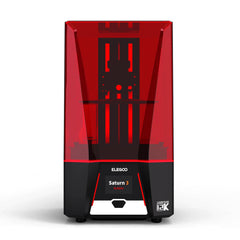- Home
- Design Showcase
- ‘Knot’ Your Average Game: DaveMakesStuff’s Celtic Chess Set
Design Showcase
DaveMakesStuff always brings an astounding level of detail to his prints, and his latest project is no exception. This month, Dave applied his 3D printing wizardry to the timeless game of chess, adding a bit of Celtic flair to the beloved battle of the minds. When Dave decided he wanted to make his own array of chess pieces, he looked to the internet for help. He did extensive research and used some valuable resources, like the International Chess Federation, for assistance. He imported some reference images into Onshape, took measurements, and began crafting his 3D chess army. Without further ado, let’s take a look at Dave’s brand-new Celtic knot chess set!
List of tools
- Elegoo Saturn 2
- Elegoo Mercury X for curing and cleaning
- BASF Ultracur3D® Resin Cleaner
- Lychee Slicer
- Phrozen Dental Study Resin
- Ntopology

Design Goals
So, as it turns out, designing a chess set isn’t the easiest task. A lot of effort has to go into making sure that the pieces look good on their own, while also remaining consistent with an entire multi-piece set. The chess pieces are broken into four distinct sections. There’s the base plate that lies upon the board, the tower in the center, the top platform that the identifying piece rests upon, and of course the identifying piece itself (the Queens crown, the bishop’s hat, etc…). Not only do these sections have to work in tandem with each other to construct a beautiful piece, but they also have to look good within the context of the set.
 This project’s Celtic charm comes in the form of the intricate latticework that Dave has interwoven into these amazing prints. These gorgeous looking 3D knots are threaded through the towers of the pieces, resting upon some brilliantly textured rocky base plates.
This project’s Celtic charm comes in the form of the intricate latticework that Dave has interwoven into these amazing prints. These gorgeous looking 3D knots are threaded through the towers of the pieces, resting upon some brilliantly textured rocky base plates.
Initially, Dave had some trouble getting the parameters of the designs right. Sometimes the knot-work would be too thick, or the rocky textures would be too pronounced. Thankfully, Dave was up to the challenge, and he continued to fine-tune his meticulous designs in nTopology (where he says the magic happens) until they were just right.
Once he was happy with his models, Dave exported the STL files to Lychee Slicer and prepared his Elegoo Saturn II for printing.

After experimenting with a few options, Dave eventually struck the perfect balance, achieving just the right level of roughness for the base plates and the ideal thickness for his knots.
The Printing Process
When he first began printing the chess pieces, Dave decided to use supports. The supports printed phenomenally, and peeled off without issue, but in this particular case they actually hindered the design. Dave needed the bottoms of his pieces to be as smooth as possible, and even the slightest bit of residue left over from the supports kept them from lying flat on the board. To remedy this issue, Dave decided he would try printing the pieces directly onto the Elegoo Saturn II’s build plate. It ended up working perfectly, and the bottoms printed completely flat. Dave was able to pop them right off the build plate and stand them upright, without any more wobbling, unsteadiness, or unwanted curvature. After all of the pieces were printed, Dave washed them in BASF Ultracur3D cleaner, and placed them into his Elegoo Mercury X for curing.
Comparing the New with the Old:
After Dave printed all of his pieces, he took some time to compare his finished models with some of the initial prototypes. The first iteration of the knight had fairly tight latticework, which looked okay on the individual piece, but didn’t fit in nicely with the rest of the set.

To remedy this, Dave expanded the lattice work, making it more consistent with the design of its neighboring piece, the bishop.
In the first design of the bishop, Dave was unhappy with the proportions of the print. The prototype bishop’s hat bulged out too much, and the height of the base plate was inconsistent with the other pieces. In order to fix this, Dave elongated the hat to make it less bulbous, and he shrunk the baseplate down to keep it in line with the rest of the set. After he made those alterations to the 3D model, the proportions looked perfect, and Dave was head-over-heels for his new and improved bishop.

The King and Queen presented Dave with a bit of a challenge as well. The pieces were certainly larger than the rest, but Dave had still hoped that he would be able to print them without the need for drainage holes. Unfortunately, a small amount of resin got trapped within, which caused uncured resin to seep out of the prototypes. Thankfully, Dave altered the new models to allow for proper drainage, and the prints came out looking just as elegant as a King and Queen should. Now that’s what I call the royal treatment! The evolution from prototype to finished product demonstrates that, in the realm of 3D printing, even seasoned professionals like Dave are still constantly learning and expanding their skill sets.

In usual DaveMakesStuff fashion, his prints ended up looking absolutely flawless. The designs may be geometrically complex, but the identity of each piece is unmistakable. Through his work on this project, Dave has successfully infused the game of chess with the complex beauty of Celtic artistry, and the results speak for themselves. This is a chess set that has to be seen to be believed. Great work as always Dave!
Download The Models here

